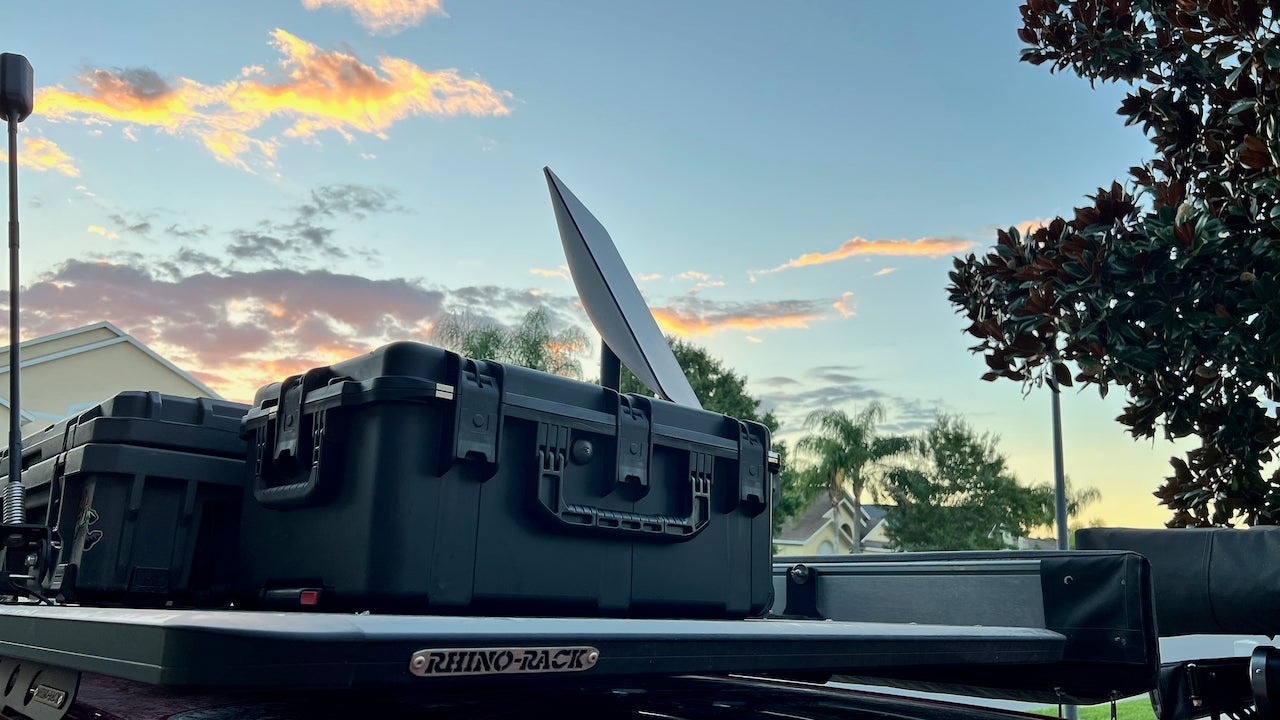Starlink RV: Worth the Hype?
Doc Rader 07.28.22

Starlink recently opened up access to a mobile version of their service, “Starlink RV” which allows you access to the service in remote areas. Bottom Line Up Front is that I found the service to be worthwhile, but you need to have clear access to the sky.
Easy to use?
Yep. Obviously, you want to trial run it on location with other services if you need to troubleshoot the setup. But running it in the field is super simple once it is set up.
You unpack the equipment, plug the components together and power the router up using an available power source–like a Goal Zero Power Station. Open the Starlink app on your mobile device and let it do its thing. It is really very plug-and-play. Then you just connect your devices to the new wifi network and enjoy your internet in otherwise dead zones.

How was the service?
The service, when I could access it, was pretty great. At one point, I was getting speeds of 127 Mbps down and 14 Mbps up, which is pretty awesome for being in the middle of nowhere with zero cell service.
My first real use of it was on a trail run with BF Goodrich, TrailRecon, and KC Lights before Overland Expo PNW in Redmond, Oregon. We traveled up the 395 in California, starting in Hesperia and stopping off a couple of nights on the way up (we had a tighter time schedule).

The first night we stayed in a dispersed area just south of the border with Oregon. I deployed the dish for the first time off-road connected to my Goal Zero Yeti 1000X. It took two minutes for the dish to sync up and start broadcasting service. I was able to hop on the internet and get some work done–as counter as that is to “being in the moment”. While not as good as my Gigabit network at home, this was plenty sufficient for everything I needed.

The next night we were near the Klamath River down in a canyon. Despite playing around with repositioning, I could not get a clear enough view of the sky for the dish to work. I figure it was mainly blockage related to the trees. I got as close to the river as possible (that was the most open overhead area).


So the lesson here is that if you need service, you need clear, open skies. Because, you know, it is talking to satellites. In space.
Portability
The original system comes in a janky cardboard box. Super minimal. It is not something that you would want to take out in the field with you. A number of people have come up with various ways and containers to stow your Starlink and components in.
If you are cash poor after dumping the $500+ for the system and the first month’s service, you can go the budget options: 14 gallon HDX tote from HomeDepot or the 12 gallon Husky.
I went with the Husky since it is waterproof. I used some of the original packing materials from the box the Starlink was shipped in to help keep things organized in the container.
You can always grab a Pelican box if you want to step up a bit. The 1610, 1630, and 1650 models will all work, though it would be wise to get the foam. The 1630 is actually large enough just to put the original cardboard box in. Keep in mind, you jump from under $40 with the Home Depot options up to $300+ with the Pelican. But you do you…
And if you are planning on spending the cheddar anyway, may as well go with fully custom and get the Caseman 20911. This case comes with custom foam cut specifically for the components AND boasts a channel in the top of the case to mount the dish’s mast. Meaning the case is also the base.


Is it worth it?
Well, it depends… This is a great option if you need to work on the road and like going back into remote areas. When I was able to get service, it was fast and solid. The cost at $135/month is not that bad, given the portability of high-speed connectivity in the wilderness.
If you have a residential dish, you can now put it into portable mode for an additional cost, which is great. The downside is that you cannot pause the service like you can with the RV version.
Ultimately if you are a remote worker and you like to travel, I think Starlink is a simple and easy way to get good service, assuming you have clear views of the sky.
Thanks to Brad Kowitz (of TrailRecon) for some of the screenshots of the Starlink in the field. Definitely subscribe if you haven’t–they make excellent off-road and overland content. Video of the trip discussed in this post: https://www.youtube.com/watch?v=KhgFW6qbqyk&ab_channel=TrailRecon
The featured image was taken by Ken Perry (and that is his Starlink on the roof of his FJ in a Caseman).
Off-Road and Overlanding is sponsored by
To subscribe, visit: https://subscribe.onxmaps.com/offroad/purchase/membership
